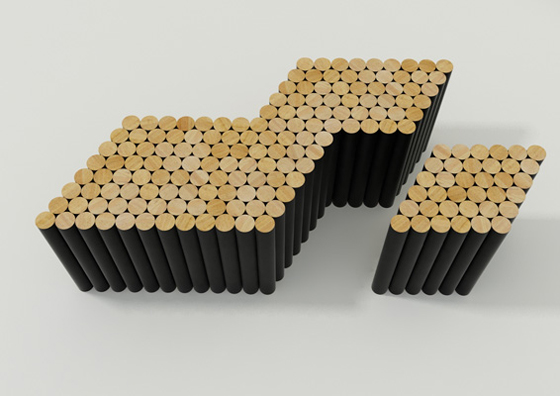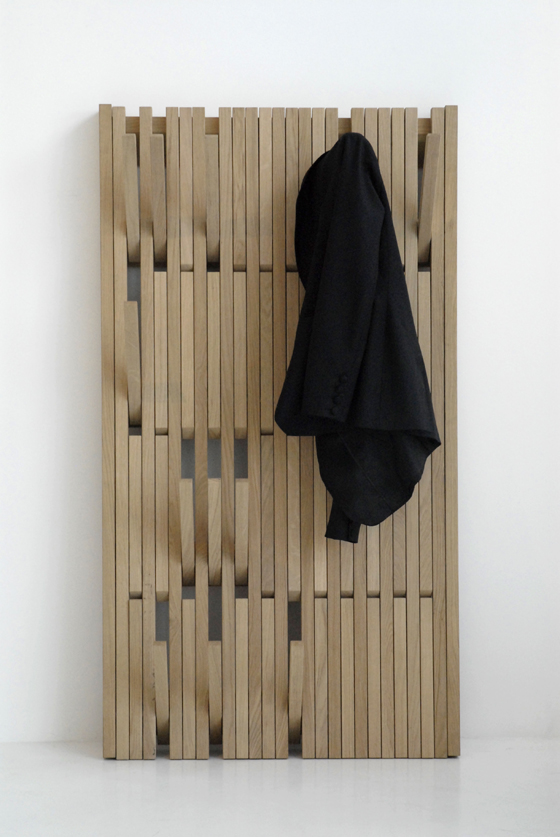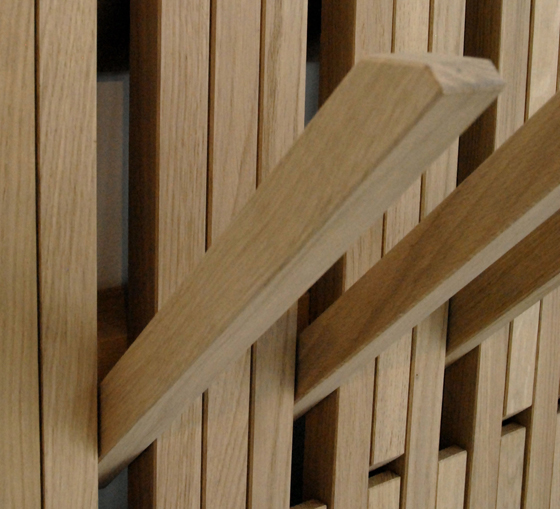Same But Different: furniture that repeats on you
Scritto da Simon Keane-Cowell
Zürich, Svizzera
27.11.10
In his analysis of how pleasure works, Freud argued that repetition – the act of doing or experiencing something over and over again – can, in its compulsiveness, be highly enjoyable. The grandaddy of psychoanalysis might, in that case, have enjoyed a number of designs presented at last month's Interieur 2010 design biennale, which play with the idea of repetition, both formally and in terms of the notion of play itself.
Uniform elements, repeated in series, provided the structural basis for three particular products on show at Interieur 2010 in Kortrijk, whose design in each case invited visitors to enter the creative process themselves by interacting with them in a fundamental, form-determining way. Indeed, literally getting to grips with these objects, changing their configuration, is a prerequisite for their use.
Belgian designer Charles Raphaël's 'Multiple' table, comprising a series of identitical wood elements, uses a magnetic system to allow the user, in theory, to perform an endless reworking of its form

Belgian designer Charles Raphaël's 'Multiple' table, comprising a series of identitical wood elements, uses a magnetic system to allow the user, in theory, to perform an endless reworking of its form
×Belgian-born Charles Raphaël is described on his website as 'a self-educated creator of objects'. Perhaps his lack of formal training has something to do with the free and fluid nature of his 'Multiple' table, which was joint winner at the Kortrijk design biennale of the 5,000-Euro Design Vlaanderen Prize. Currently being produced by the designer, but destined for serial production, the table features a group of identical solid-beech vertical elements, held together by a magnetic system. Creative play is encouraged: the user can quite easily change the configuration of the piece, thus creating a number of different aesthetic and practical possibilities. One table can become two, for example. Or how about forming the shape of your home country, as illustrated here? (Note: this doesn't have to be Belgium.)
There's a corner of a living room where it will be forever Belgium: Charles Raphaël's 'Multiple' table configured, somewhat ironically, in the form of the designer's home country

There's a corner of a living room where it will be forever Belgium: Charles Raphaël's 'Multiple' table configured, somewhat ironically, in the form of the designer's home country
×Raphaël tells Architonic there's 'nothing magical' about the product. But we think it's rather special. So does Prince Philippe of Belgium, who has one of the tables in his private collection.
Developed in response to a brief set by Alain Berteau to rethink the coat rack as an object type, Patrick Seha's 'Piano' for Belgian label Feld turns an everyday object into a sculptural piece that celebrates the pleasure of repetition

Developed in response to a brief set by Alain Berteau to rethink the coat rack as an object type, Patrick Seha's 'Piano' for Belgian label Feld turns an everyday object into a sculptural piece that celebrates the pleasure of repetition
×Patrick Seha's 'Piano' wall-mounted coat-hanger panel invites the user to play with it. Indeed, it requires you to open out its battens for it to function

Patrick Seha's 'Piano' wall-mounted coat-hanger panel invites the user to play with it. Indeed, it requires you to open out its battens for it to function
×Such modesty can also be found in leading Belgian designer Alain Berteau's analysis of the 'Piano' coat rack, designed by one of his students, Patrick Seha, and produced by Belgian design label of the moment Feld. Describing it to Architonic as 'just some bits of wood brought together', Berteau was, however, quick to qualify this statement by underscoring the value of such consciously lo-tech design. 'Do you really need a big piece that stands in the middle of the room?' he asked, this being the question he posed his class as a brief to think about how a traditional object type could be rethought.
Polish design duo Beyond have created a bench that consists of isomorphic, repeated elements, which, when rotated, create different seating possibilities

Polish design duo Beyond have created a bench that consists of isomorphic, repeated elements, which, when rotated, create different seating possibilities
×Seha's response is a product that marries utilitarian function with a sculptural one. Consisting of a series of repeated identical oak battens, organised to create a vertically oriented, wall-mounted panel, playful interaction with the piece is not only encouraged by its design, it's required. You have to pull out its pivoting battens to create the hooks on which to hang your stuff. And it's precisely this highly ludic repetition that makes the object so fascinating. Seeing grown men spend minutes in front of the piece at the Kortrijk fair, folding its parts out and in, made us smile.
Beyond's 'Coffee Bench' features seating, armrests and surfaces that function as side tables, depending on how you configure its constituent elements

Beyond's 'Coffee Bench' features seating, armrests and surfaces that function as side tables, depending on how you configure its constituent elements
×The rather prosaically named 'Coffee Bench' by Polish design studio Beyond (Karolina Tylka and Szymon Nawoj), also shown at Interieur 2010, presents users with, in contrast to its title, a rather nice poetic opportunity to determine its form. Rotating its repeated constituent elements produces a range of structural possibilities, creating seating, armrests and surfaces that function as side tables. The permutations are many. Originally conceived as a piece of outdoor furniture, the bench, available in different lengths from one to three metres, also comes upholstered in leather or felt for those of you of a more sensitive nature. Production is currently located in Poland, but Beyond are in talks with Italian and UK manufacturers about a plastic rotomoulded version. Now, Freud would be pleased.





